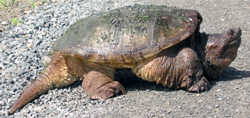Chelydra serpentina
Snapping Turtle
Identification
The Snapping Turtle is probably the most common turtle in Vermont. The carapace is shallowly domed with a strongly toothed posterior margin. The plastron is narrow, leaving the turtle always partially exposed. It is uniformly grayish brown with no colorful markings, spots, or stripes.
The Snapping Turtle can get quite large. The shells of adults range from 10-18 inches long. The young have three keels that disappear with age and wear. They have a long tail that has spines along the top. They also have a long neck.
When out of the water they are defensive. To prevent injury to yourself, you should stay out of reach of their long necks and strong jaws.
Range/Habitat
They live in still or slow-moving bodies of water, particularly those with soft bottoms and emergent vegetation, such as cattails. The females leave the water in May and June to lay their eggs on land.
Status
This species has a state natural heritage rank of S5 (common). Please report sightings of this species in Vermont if you have not reported them within the last five years from a given location. Any natural history observations (feeding, migrations, road crossing areas, early or late season appearance, abnormalities, etc.) are appreciated. Photographs are always helpful, particularly if your report is the first report of this species from a town.
More Info
- Chelydra serpentina at Animal Diversity website
- Chelydra serpentina at CARCNET website
Species summary written by Kaile Burgess.
How to Help a Snapping Turtle Cross The Road
Video from the Toronto Zoo YouTube channel.



